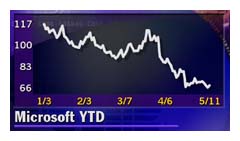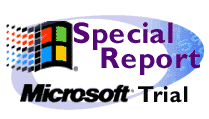|
DOJ defends breaking up Microsoft
|
 |
May 17, 2000: 9:29 p.m. ET
Justice and 19 states defend Microsoft breakup proposal in legal brief
|
NEW YORK (CNNfn) - In a filing made Wednesday evening with a federal court in Washington, the Justice Department and 19 states strongly defended their proposal to break up Microsoft Corp. to prevent the software giant from violating antitrust laws.
The 70-page filing is the government's last effort to influence U.S. District Judge Thomas Penfield Jackson before the judge holds a court hearing in the Microsoft antitrust case on May 24. The government is trying to convince Judge Jackson to split Microsoft into two separate companies, rather than adopting a much milder series of restrictions on business practices that Microsoft proposed to the court last week.
 "What remedy does Microsoft propose to undo the damage to competition caused by its past illegal conduct? Nothing," the government said in its brief filed in U.S. District Court. "What remedy does Microsoft propose to undo the damage to competition caused by its past illegal conduct? Nothing," the government said in its brief filed in U.S. District Court.
The government's brief argues that Microsoft failed to address the antitrust violations that Judge Jackson found in his "conclusions of law" issued on April 3.
"Instead, it offered a cosmetic remedy that would have virtually no competitive significance," the government's filing said. "It would neither undo the harm that Microsoft inflicted on competition nor prevent Microsoft from illegally using its monopoly power to inflict similar harm in the future."
Specifically, the Redmond, Wash.-based software giant's proposed remedy would leave it free to tie together two separate products that have no technological integration, make predatory expenditures designed to eliminate competition, and retaliate against PC makers that distribute non-Microsoft products or refuse to distribute Microsoft ones, the government said.
While Microsoft wants until Dec. 4 to prepare an argument against splitting the company in two, the government's filing said that the company's request is "a transparent effort to delay the determination and implementation of a remedy for its illegal acts as long as possible."
 "It's unfortunate but not surprising that the government has filed a document filled with rhetoric in its attempt to defend a very extreme remedy proposal," said Microsoft spokesman Jim Cullinan. "Beyond the rhetoric, we do not believe there is any basis for these kinds of excessive actions which would significantly harm consumers, the high-tech industry, and the economy." "It's unfortunate but not surprising that the government has filed a document filled with rhetoric in its attempt to defend a very extreme remedy proposal," said Microsoft spokesman Jim Cullinan. "Beyond the rhetoric, we do not believe there is any basis for these kinds of excessive actions which would significantly harm consumers, the high-tech industry, and the economy."
Regardless of Judge Jackson's final ruling in the case, Microsoft plans to appeal.
Iowa Attorney General Tom Miller, who leads a working group of the states suing Microsoft, issued a statement saying, "Apparently, Microsoft is still in denial."
"It has yet to face up to the harm it has done, and it willfully misunderstands what the remedy is for," Miller said. "The purpose of the remedy is to restore to the marketplace the competitive dynamic that Microsoft has suppressed."
Judge Jackson's conclusions of law
On April 3, Judge Jackson concluded that Microsoft (MSFT: Research, Estimates) maintained its monopoly power over personal computer operating systems by anticompetitive means and attempted to monopolize the Web browser market. The judge asked both Microsoft and the government to submit proposed remedies to stem the company's anti-competitive behavior.
On April 28, the government proposed that Microsoft be split into two competing entities - one to contain its Windows operating systems, which run most of the world's personal computers, and another to contain the rest of its business lines, including the popular Microsoft Office suite of applications. Microsoft fired back on May 10 with its own set of proposed remedies that it said would address the government's concerns about competition in the Web browser and computer operating systems markets.
 While Judge Jackson gave the government a week to review Microsoft's proposed remedies, the federal government and the states waited only a few hours last week to blast the software company's proposal. That rebuttal continued in Wednesday's brief. While Judge Jackson gave the government a week to review Microsoft's proposed remedies, the federal government and the states waited only a few hours last week to blast the software company's proposal. That rebuttal continued in Wednesday's brief.
The government reiterated in its brief that Microsoft's proposed remedies demonstrated a "persistent unwillingness to abandon its widespread use of unlawful practices to maintain and extend its Windows monopoly."
Shares of Microsoft (MSFT: Research, Estimates) fell 1-13/16 to 67-11/16 Wednesday, amid a broad-based decline in tech stocks. Shares rebounded to 3/16 to 67-7/8 in after-hours trade. 
|
|
|
|
|
 |

|

